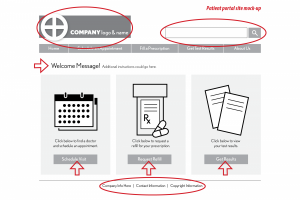Simple design is good for your health

by Jeff Merron '92 (Ph.D.)
According to U.S. News & World Report, the face of everyday health care is changing, thanks to the increasing use of patient portals by family physicians.
The portals enable patients to log on to a website to perform routine tasks, such as making appointments, checking test results and refilling prescriptions. Portals also enable patients to ask questions of doctors and nurses without the usual long wait for a return phone call.
But for doctors and other health care providers who set up shop on the Internet, getting patients to log into and use portals is a major challenge. As of mid-2015, less than 30 percent of patients surveyed by athenaResearch use portals, with resistance to use strong across all age groups.
According to Allison Lazard, an assistant professor at the UNC Hussman School of Journalism and Media, the problem isn’t just that patients won’t sign up for the portals. In a recent study published in the Journal of the American Medical Informatics Association, she writes, “Many individuals enrolled in patient portals do not use them, and the barriers to adoption and continuance — actual use after enrollment — of patient portal use remain unclear.”
Lazard’s paper, “Design simplicity influences patient portal use: the role of aesthetic evaluations for technology acceptance,” was published in December 2015, and is based on research she conducted while completing her doctorate in advertising at the University of Texas at Austin.
Over a six-month time period, Lazard and a team of researchers partnered with the Austin Regional Clinic to survey patients who used its website. “They provided me with access and, in exchange, I gave them information,” says Lazard.
While there are many complex technological issues related to putting personal health care information online (privacy and security, for example), Lazard’s interest was, in a way, only skin deep. Her key finding: Simple design, reflected in how easy patients believe a portal is to use, encourages greater use — even if there are other problems with the site.
“If users think it’s easy, they’re more likely to use it, because they have confidence,” says Lazard. “If you have a nice layout (design), people are more likely to spend time getting over the hurdles.”
The use of design to better communicate health information is at the core of Lazard’s research interests, which have grown naturally from her professional background. Prior to her studies in Austin, she worked as a commercial photographer in Chicago, and designed digital and print communications for DWA Healthcare Communications Group in Indianapolis.
Lazard’s current research includes testing design strategies for a website to simply and clearly communicate to a lay audience the health risks of chemicals in cigarette smoke. Her research is part of a larger tobacco study funded by the U.S. Food and Drug Administration and National Cancer Institute through the UNC Gillings School of Global Public Health. Noel Brewer of Gillings is the principal investigator.
Lazard has also received a grant from the UNC Center for Regulatory Research on Tobacco Communication to help develop a site that communicates the risks of e-cigarette, cigarillo and hookah smoking. The site is to be targeted at adolescents and young adults.
The School of Media and Journalism has a long history of research in health communication, and Lazard recently joined other media and journalism professors as a faculty affiliate on UNC’s Interdisciplinary Health Communication initiative. The initiative includes a master’s degree and a graduate-level certificate program and is spearheaded by professors from media and journalism, public health, information and library science, and psychology.
While the specific topics and subject areas of her studies may vary, and the media used to communicate health ideas will evolve, Lazard says the problems that her research address center on universal challenges.
“Design is a very personal experience, but we can study it because it’s also very shared,” she says. “For example, we associate specific colors with specific brands, but each person may react differently to those colors,” she says.
And while the Internet is fragmenting — with much use moving from the desktop to tablets and smartphones — the fundamental concerns remain the same. “The perceived ease of use will always be an issue,” Lazard says. “We go through different design phases. Trends will change, but how we think about getting from an objective design to a subjective experience will always be there.”
Jeff Merron is a freelance journalist who was a staff writer for ESPN.com, a columnist for Macworld.com and a contributer to many other websites as well as national publications. He received his a Ph.D. in Mass Communication from UNC in 1992.